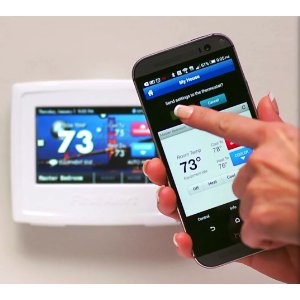-

Comparing traditional thermostat vs a Wi-Fi -Thermostat fall into two basic categories: programmable and non-programmable. Non-programmable thermostats are the most affordable, but very outdated. All settings are done manually and every temperature change requires you taking a trip to the thermostat. Programmable thermostats have a digital face that will allow programming the heat and cooling cycles based on time(s) of the day. But even with programmable thermostats still do not offer the convenience of having the ability to control your home through features such as remote programming via an app. Having what we call a smart thermostat, means you are synced up with a Wi-Fi router and you have the capacity of having remote access from your smart phone or the option to access it from your computer or tablet. No matter where you are, a Wi-Fi thermostat keeps you connected to your home allowing you to have access in the palm of your hands.
Smart thermostat controls are much more than just controlling the temperature from your smart phone or computer. A Wi-Fi thermostat will act as a seamless component in managing your home while away from your home. Choosing a Wi-Fi smart thermostat means you have the ability to manage a wide array of features, not just temperature.
-Heating and Cooling stages- A capable thermostat will allow you to control your heating and cooling systems separately.
-Temperature Swings- Managing the home and the varying temperature swings the will allow you to program the thermostat to prevent the system from going on and off with small variances in temperature swings. This will help in managing energy savings.
-Keypad Lock- A feature that will prevent others from tampering with the programmed settings.
-Auto Changeover- Allows the thermostat to automatically determine the time to switch back and forth between heating and cooling,
-Energy Management- Help in decreasing your energy or gas bills by only running the system when you are home, or some smart thermostats learn your habits automatically.
-Scheduling-Available set points for 7 days a week and multiple times during the day.
-Target Temperature-Determines the amount of time it takes to reach your target temperature and will turn system on according to the time you wish the temperature to be met.
-Weather forecasting-On screen capability to see current weather and temperature and the forecast for up to 7 days out.
-Feedback- Smart thermostats will provide feedback on the usage of electricity, or gas at the touch of a screen.
When it comes to home automation, few devices can make as big an impact on your energy usage as a new thermostat will. Your home’s heating and air conditioning system is typically the largest energy consumer in your home, often using more than 4 kilowatts per hour. Having greater control of your system, you can substantially curb your home’s energy usage. It’s important to understand what types of temperature, energy management and sensor features to look for. Combining these pieces of the puzzle will allow you to get the right smart thermostat for your home. Share your needs with a professional HVAC contractor and allow them to help you make the best choice for you and your home.
Trusted And Proven Heating And Air Conditioning For Over 30 Years
Licensed HVAC For Installations, Repair And Maintenance~Authorized Generac Sales & Service Contractor
Call (916) 933-2683 To Schedule Your Appointment
Local Heating And Cooling Contractor At 5011 Golden Foothill Pkwy #5, El Dorado Hills, CA 95762
Copyright © 2016, Performance Heating And Air Conditioning, Inc. All Rights Reserved. Terms Of Service | Privacy Policy | Sitemap


I love to hear your reaction
Send Cancel